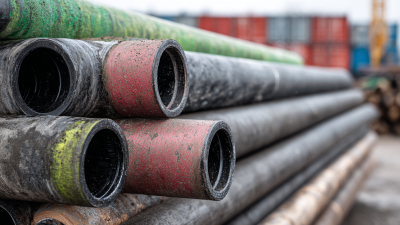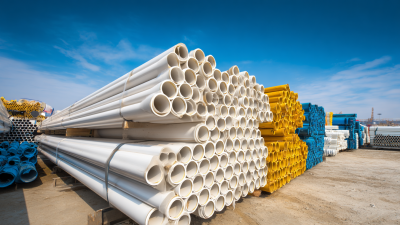Exploring the Latest Innovations in Pipe Supplies: What You Need to Know for Your Projects
In today's ever-evolving construction landscape, the significance of high-quality pipe supplies cannot be overstated. As projects become more complex and stringent regulatory standards emerge, innovative advancements in pipe supply technologies are crucial for ensuring optimal performance and reliability. This exploration of the latest innovations in pipe supplies will delve into cutting-edge materials, manufacturing processes, and smart technologies that are transforming the industry. From enhanced durability to eco-friendly options, these innovations not only improve functionality but also align with sustainability goals. As we navigate through the essential developments, project managers and contractors will gain valuable insights to make informed decisions that enhance project efficiency and longevity. Ultimately, understanding these advancements is paramount for anyone involved in construction, plumbing, and infrastructure projects, ensuring they are well-equipped for the challenges of today's market.

Latest Trends in Pipe Materials: Exploring the Shift Towards Sustainable Options
The construction industry is seeing a significant shift towards sustainable options in pipe materials as environmental awareness increases. Traditional materials such as PVC and metal are being scrutinized for their long-term impact on the environment. Instead, innovative alternatives like bio-based plastics and recycled materials are gaining traction. These materials not only reduce waste but also help construction projects meet stringent sustainability goals.
Tips for selecting sustainable pipe materials include researching the lifecycle assessment of products, ensuring they are certified by relevant environmental standards, and considering the long-term durability of the materials. Additionally, engage with suppliers who prioritize sustainability in their manufacturing processes. This approach can lead to cost savings over time and strengthen your project's commitment to environmental stewardship.
Another exciting trend is the integration of smart technologies within pipe systems. IoT-connected pipes can monitor water quality and pressure in real time, significantly reducing waste and improving maintenance efficiency. When choosing pipe supplies, consider options that offer these advanced features as they represent the future of sustainable construction practices.

Innovative Pipeline Inspection Technologies: Enhancing Efficiency and Safety in Projects
The landscape of pipeline construction and maintenance is rapidly evolving, driven by innovative inspection technologies that enhance both efficiency and safety. According to a recent report from the Pipeline and Hazardous Materials Safety Administration (PHMSA), nearly 30% of pipeline incidents are attributed to equipment failures, underscoring the crucial need for advanced monitoring solutions. Innovations such as drones equipped with high-resolution cameras and sophisticated sensors are revolutionizing how pipelines are inspected. These technologies not only reduce human risk but also allow for more frequent and thorough evaluations of pipeline integrity.
**Tips:** When considering pipeline inspection technologies for your projects, invest in tools that allow for real-time data analysis. This can significantly reduce the response time to potential issues. Additionally, making use of software that integrates geographic information system (GIS) technology can further enhance your ability to monitor pipeline networks effectively.
With the integration of artificial intelligence in data analysis, companies can now predict maintenance needs before failures occur. A study by the American Society of Civil Engineers (ASCE) indicated that predictive maintenance can reduce downtime by up to 50%. This proactive approach is key for maintaining operational efficiency and ensuring the safety of pipeline operations. Embracing these emerging technologies will not only protect investments but also enhance the overall reliability of pipeline systems.
Exploring the Latest Innovations in Pipe Supplies: What You Need to Know for Your Projects - Innovative Pipeline Inspection Technologies: Enhancing Efficiency and Safety in Projects
| Technology | Description | Benefits | Applications |
|---|---|---|---|
| Drone Inspections | Utilizing drones equipped with high-resolution cameras and sensors for visual inspections. | Increases safety, reduces inspection times, and enhances data collection capabilities. | Oil and gas pipelines, water supply systems, and infrastructure monitoring. |
| Robotic Crawlers | Remote-controlled robots that can navigate through pipes to assess their condition. | Allows for thorough inspections in hard-to-reach areas, reducing downtime. | Sewage systems, drainage pipes, and industrial pipelines. |
| Ultrasonic Testing | Using high-frequency sound waves to detect flaws within pipe materials. | Provides accurate measurement of thickness; non-destructive testing. | Manufacturing quality control, pipeline integrity assessments. |
| Smart Sensors | Sensors that monitor pipeline conditions in real-time, gathering data on stress, pressure, and flow. | Enhanced predictive maintenance capabilities, reducing the risk of failures. | Gas and oil pipelines, water distribution systems. |
| Laser Scanning | 3D laser scanners create precise models of pipeline structures and surrounding environments. | Accurate mapping for better planning and design; efficient spatial analysis. | Construction projects, retrofitting, and maintenance planning. |
Digital Solutions in Pipe Supply Chain Management: Boosting Productivity and Reducing Costs
In recent years, digital solutions have emerged as a cornerstone in pipe supply chain management, significantly enhancing productivity and driving down costs. According to industry experts, integrating Internet of Things (IoT) technology into supply chains has not only improved visibility but also enabled real-time data analytics that facilitates informed decision-making. Reports indicate that organizations leveraging IoT have witnessed a productivity boost of up to 20%, showcasing the profound impact of digitization on operational efficiency.
Furthermore, advancements in supply chain management tools have been pivotal in addressing the challenges posed by fluctuating costs and logistics complexities. For instance, companies are increasingly adopting cloud-based platforms that streamline procurement processes and inventory management. These innovations not only bring about substantial cost savings—estimated at roughly 15% by some analysts—but also empower businesses to respond more agilely to market demands. The shift towards smart, sustainable manufacturing practices highlights the importance of adopting comprehensive digital strategies to remain competitive in a rapidly evolving marketplace.
Productivity Improvement in Pipe Supply Chain Management
This chart illustrates the increase in productivity attributed to digital solutions in pipe supply chain management. The data shows a noteworthy rise from 20% productivity before the innovations to 50% after implementing digital solutions.
Smart Pipe Systems: Leveraging IoT for Real-Time Monitoring and Maintenance
The integration of Internet of Things (IoT) technology into pipe systems is revolutionizing the way industries approach real-time monitoring and maintenance. According to a recent report by MarketsandMarkets, the smart pipe systems market is projected to grow from $6.5 billion in 2023 to $14.8 billion by 2028, exhibiting a remarkable compound annual growth rate (CAGR) of 18.0%. This rapid growth showcases the increasing demand for advanced analytics and enhanced operational efficiency within the pipeline industry.
IoT-enabled smart pipe systems utilize sensors and data analytics to provide actionable insights, allowing for proactive maintenance and reduced downtime. For instance, companies can monitor pressure, temperature, and flow rates in real-time, identifying leaks or blockages before they escalate into major problems. A study by McKinsey highlights that effective IoT implementation can decrease maintenance costs by 30-50%, demonstrating significant ROI for businesses investing in these technologies. As organizations strive for sustainability and cost-effectiveness, the adoption of IoT in pipeline management becomes an essential strategy for modernizing infrastructure and improving resource management.

Impact of Regulations on Pipe Supply Innovations: Adapting to Industry Standards and Compliance
The impact of regulations on pipe supply innovations cannot be overstated, as these guidelines shape the development and adoption of new materials and technologies in the industry. As environmental standards become increasingly stringent, manufacturers are compelled to innovate in order to comply with regulations while also enhancing the performance and durability of their products. For instance, the shift towards sustainable materials has prompted many companies to explore alternatives that reduce carbon footprints and improve recyclability. This adaptation not only meets regulatory requirements but also resonates with environmentally conscious consumers.
Moreover, compliance challenges often drive technological advancements in pipe supply. Innovations such as smart piping systems with embedded sensors reflect a proactive approach to meeting regulatory standards. These systems can monitor conditions in real time, ensuring that any potential issues are flagged before they escalate into significant problems. As regulations continue to evolve, industry players must stay ahead of the curve by embracing these innovations, positioning themselves as leaders in a competitive market while ensuring compliance with the latest industry standards.
Related Posts
-

Essential Well Pump Supplies: Maximizing Efficiency and Longevity for Your Water System
-

The Evolution of Plastic Pipe: Sustainable Solutions for Modern Infrastructure
-

Essential Water Well Supplies: Ensuring Sustainable Water Access with 87% Efficiency in Groundwater Usage
-

Understanding the Benefits and Applications of PVC Water Pipes in Modern Plumbing Systems
-

Understanding the Rapid Growth of PVC Supplies Market with Insights from Industry Trends and Data Analysis
-

Essential Guide to Choosing the Right Water Well Supplies for Sustainable Water Management
